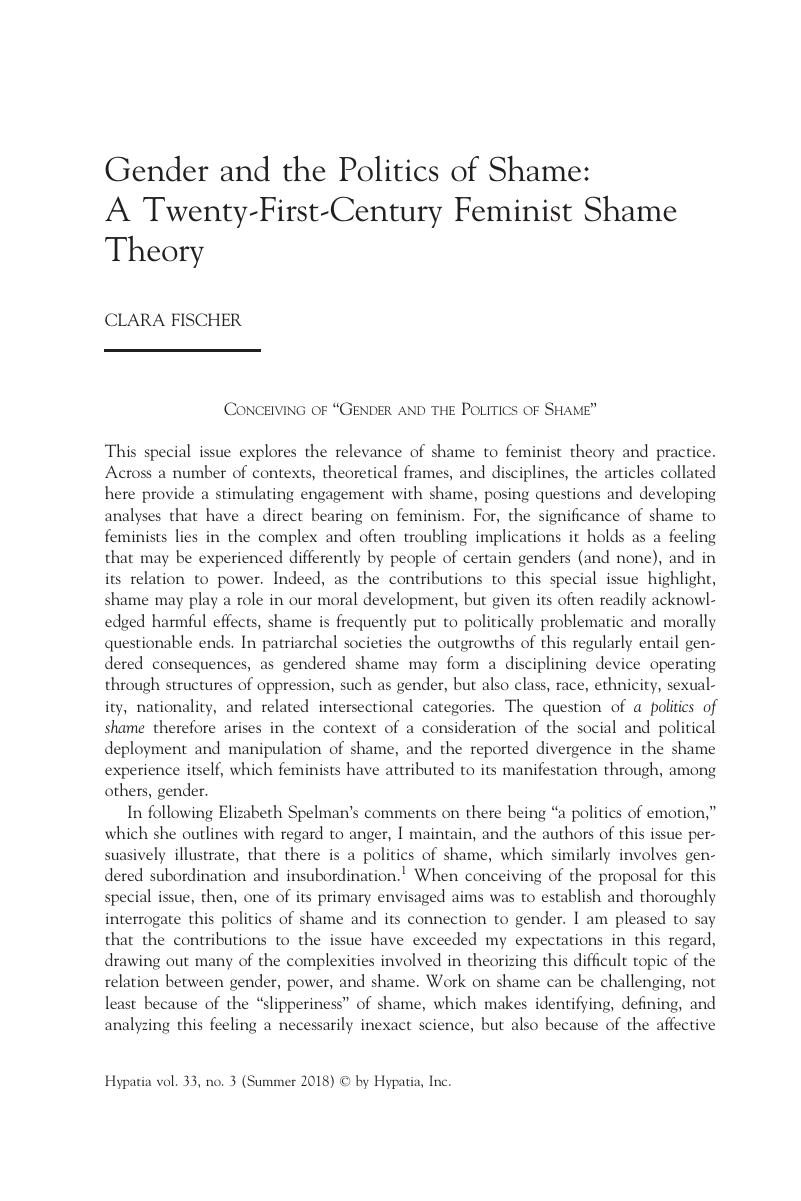Crossref Citations
This article has been cited by the following publications. This list is generated based on data provided by Crossref.
Fischer, Clara
2019.
Abortion and Reproduction in Ireland: Shame, Nation-building and the Affective Politics of Place.
Feminist Review,
Vol. 122,
Issue. 1,
p.
32.
Shefer, Tamara
and
Munt, Sally R
2019.
A feminist politics of shame: Shame and its contested possibilities.
Feminism & Psychology,
Vol. 29,
Issue. 2,
p.
145.
Fischer, Clara
2020.
Feminists Redraw Public and Private Spheres: Abortion, Vulnerability, and the Affective Campaign to Repeal the Eighth Amendment.
Signs: Journal of Women in Culture and Society,
Vol. 45,
Issue. 4,
p.
985.
Hodge, Lisa
2021.
Eating Disorders and Child Sexual Abuse.
p.
221.
Cavallo, Gianluca
2021.
Injustice, Shame, and the Moral Grammar of Social Struggles.
Critical Horizons,
Vol. 22,
Issue. 4,
p.
386.
Whelan, Joe
2021.
Work and thrive or claim and skive: Experiencing the ‘toxic symbiosis’ of worklessness and welfare recipiency in Ireland.
Irish Journal of Sociology,
Vol. 29,
Issue. 1,
p.
3.
Hodge, Lisa
2021.
Eating Disorders and Child Sexual Abuse.
p.
115.
Capous-Desyllas, Moshoula
and
Goulah-Pabst, Dorothy M.
2022.
Achieving Empowerment over Shame through the Arts: A Photovoice Study Exploring Shame and Resistance among Women Sex Workers.
Journal of Evidence-Based Social Work,
Vol. 19,
Issue. 2,
p.
228.
Levitanus, Mariya
2022.
Uyat and the Culture of Shame in Central Asia.
p.
117.
Salam, Rauha
2022.
In a World Where You can be Anyone: An Investigation into the Gendered Social Practices of Pakistani Facebook Users.
Gender Issues,
Vol. 39,
Issue. 3,
p.
253.
Tarzibachi, Eugenia
2022.
Menstrual Bodies and Gender.
p.
23.
Smith‐Oka, Vania
2022.
You're joking: Exploring humour and humiliation as forms of shame and obstetric violence within medical encounters.
Journal of Evaluation in Clinical Practice,
Vol. 28,
Issue. 5,
p.
917.
Hodgson, Jodie
2022.
Gender, Power and Restorative Justice.
p.
169.
Elmeligy, Nehal
2022.
Airing Egypt’s Dirty Laundry: BuSSy’s Storytelling as Feminist Social Change.
Gender & Society,
Vol. 36,
Issue. 1,
p.
112.
Hodgson, Jodie
2022.
Gender, Power and Restorative Justice.
p.
145.
Preece, Chloe
and
Whittaker, Laryssa
2023.
Towards glitch pedagogy.
Journal of Marketing Management,
Vol. 39,
Issue. 1-2,
p.
68.
Levitanus, Mariya
2023.
Uyat und die Kultur der Scham in Zentralasien.
p.
129.
Jóhannesdóttir, Gréta Bergrún
and
Skaptadóttir, Unnur Dís
2023.
“You Don’t Want to Be One of Those stories” Gossip and Shame as Instruments of Social Control in Small Communities.
NORA - Nordic Journal of Feminist and Gender Research,
Vol. 31,
Issue. 4,
p.
323.
Xiaochun, Lei
2024.
Female body shame, subjectivity, and community in Salman Rushdie’s
Shame
.
European Journal of English Studies,
Vol. 28,
Issue. 2-3,
p.
216.
Haltorp, Hära Jess
Prytz, Sara Backman
Danielsson, Anna
and
Almqvist, Jonas
2024.
‘Shameful histories’ – shame and sex perceived by secondary school students in history education.
History Education Research Journal,
Vol. 21,
Issue. 1,



